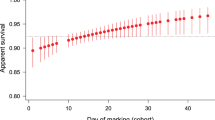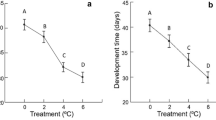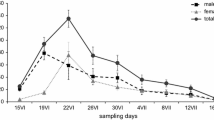Abstract
We estimated lifetime reproductive success of Euphydryas editha bayensis (Nymphalidae), a federally listed threatened butterfly, based on age-specific fecundity and both adult and offspring survival. Our results indicate that the relative timing of adult emergence and larval hosplant senescence strongly influenced reproductive success of females. For 1992, we estimated that only 8–21% of the eggs laid by females emerging on the 1st day of the 4-week flight season would produce larvae that reach diapause. This figure dropped to 1–5% for females emerging 7 days into the flight season. Within our entire sample, we estimated that 64–88% of the females produced offspring with less than a 2% probability of reaching diapause. These estimates are particularly striking given that they are based on only one source of larval mortality — prediapause starvation due to hostplant senescence. This dependence of reproductive success on the relative timing of female emergence and hostplant senescence may reduce effective population size and render E. editha bayensis especially vulnerable to local extinction events.
Similar content being viewed by others
References
Arnold SJ, Wade MJ (1984) On the measurement of natural and sexual selection. Evolution 38:709–719
Barrowelough GF, Rockwell RF (1993) Variance in lifetime reproductive success: estimation based on demographic data. Am Nat 141:281–295
Boggs CL (1986) Reproductive strategies of female butterflies: variation in and constraints on fecundity. Ecol Entomol 11:7–15
Clutton-Brock TH (ed) (1988) Reproductive success: studies of individual variation in contrasting breeding systems. University of Chicago Press, Chicago
Dobkin DS, Olivieri I, Ehrlich PR (1987) Rainfall and the interaction of microclimate with larval resources in the population dynamics of checkerspot butterflies (Euphydryas editha) inhabiting serpentine grassland. Oecologia 71:161–166
Ehrlich PR (1961) Intrinsic barriers to dispersal in checkerspot butterflies. Science 134:108–109
Ehrlich PR (1965) The population biology of the butterfly, Euphydryas editha. II. The structure of the Jasper Ridge colony. Evolution 19:327–336
Ehrlich PR (1983) Genetics and the extinction of butterfly populations. In: Cox CS, Chambers S, MacBryde B, Thomas W (eds) Genetics and conservation. Benjamin/Cummings, Menlo Park, pp 152–163
Ehrlich PR, Murphy DD, Singer MC, Sherwood CB, White RR, Brown IL (1980) Extinction, reduction, stability, and increases: the response of checkerspot butterfly (Euphydryas) populations to the California drought. Oecologia 46:101–105
Ehrlich PR, Launer AE, Murphy DD, (1984) Can sex ratio be determined? The case of a population of checkerspot butterflies. Am Nat 124:527–39
Harrison S, Murphy DD, Ehrlich PR (1988) Distribution of the bay checkerspot butterfly, Euphydryas editha bayensis: evidence for a metapopulation model. Am Nat 132:360–382
Istock CA (1981) Natural selection and life history variation: theory plus lessons from a mosquito. In: Denno RF, Dingle H (eds) Insect life history patterns: habitat and geographic variation. Springer. Berlin Heidelberg New York, pp 113–128
Labine PA (1968) The population biology of the butterfly, Euphydryas editha. VIII. Oviposition and its relation to patterns of oviposition in other butterflies. Evolution 22:799–805
Lomnicki A (1978) Individual differences between animals and the natural regulation of their numbers. J Anim Ecol 47:461–475
Mueller LD, Wilcox BA, Ehrlich PR, Heckel DG, Murphy DD (1985) A direct assessment of the role of genetic drift in determining allele frequency variaiton in populations of Euphydryas editha. Genetics 110:495–511
Murphy DD, Ehrlich PR (1989) Conservation biology of California's remnant native grasslands. In: Huenneke LF, Mooney H (eds) Grassland structure and function: California annual grasslands. Kluwer Academic. Dordrecht, pp 201–211
Murphy DD, Launer AE, Ehrlich PR (1983) The role of adult feeding in egg production and population dynamics of the checkerspot butterfly Euphydryas editha. Oecologia 56:257–263
Murphy DD, Menninger MS, Ehrlich PR, Wilcox BA (1986) Local population dynamics of adult butterflies and conservation status of two closely related species. Biol Conserv 37:201–223
Murphy DD, Freas KE, Weiss SB (1990) An environment-meta-population approach to population viability analysis for a threatened invertebrate. Conserv Biol 4:41–51
Singer MC (1971) Ecological studies on the butterfly Euphydryas editha. PhD Dissertation, Stanford University, Stanford
Singer MC (1972) Complex components of habitat suitability within a butterfly colony. Science 176:75–77
Singer MC, Ehrlich PR (1979) Population dynamics of the checkerspot butterfly Euphydryas editha. Fortschr Zool 25:53–60
Tallamy DW, Denno RF (1981) Alternative life history patterns in risky environments: an example from lacebugs. In: Denno RF, Dingle H (eds) Insect life history patterns: habitat and geographic variation. Springer Berlin Heidelberg New York, pp 113–128
Weiss SB, Murphy DD, White RR (1988) Sun, slope, and butterflies: topographic determinants of habitat quality for Euphydryas editha. Ecology 69:1486–1496
White RR (1986) Pupal mortality in the Bay checkerspot butterfly (Lepidoptera: Nymphalidae). J Lep Res 25:52–62
Author information
Authors and Affiliations
Rights and permissions
About this article
Cite this article
Cushman, J.H., Boggs, C.L., Weiss, S.B. et al. Estimating female reproductive success of a threatened butterfly: influence of emergence time and hostplant phenology. Oecologia 99, 194–200 (1994). https://doi.org/10.1007/BF00317101
Received:
Accepted:
Issue Date:
DOI: https://doi.org/10.1007/BF00317101




